Performance Appraisal of Controlled Low-strength Material Using Sewage Sludge and Refuse Incineration Bottom Ash*
2012-03-22ZHENGuangyin甄广印ZHOUHaiyan周海燕ZHAOTiantao赵天涛andZHAOYoucai赵由才
ZHEN Guangyin (甄广印), ZHOU Haiyan (周海燕), ZHAO Tiantao (赵天涛) and ZHAO Youcai (赵由才),**
1 The State Key Laboratory of Pollution Control and Resource Reuse, School of Environmental Science and Engineering, Tongji University, Shanghai 200092, China
2 Shanghai Laogang Waste Treatment Company, Shanghai 201302, China
1 INTRODUCTION
Controlled low-strength material (CLSM) refers to a cementitious material whose characteristics are similar to stabilized soils [1] and which permits re-excavation afterwards if necessary. The American Concrete Institute (ACI) Committee 229 has defined CLSM as a material resulting in a compressive strength of 8.3 MPa or less after hardening [2]. CLSM,known as “self-compacting and flowable”, allows perfect filling of any void [3] and is used primarily for soil and structural filling in civil engineering works such as pipeline bedding, foundation backfill and abandoned mines, etc. The material is durable, economical, easy placement without vibration, not laborintensive [4], and therefore seems more attractive and practical as compared to conventional backfills.
During past decades, significant efforts have been made in utilizing various industrial by-products in the production of CLSM, and the reported results were extremely promising. Katz and Kovler conducted a preliminary study on the use of cement kiln dust(CKD), asphalt dust, coal ashes and quarry waste in CLSM [3]. The mixture tested with 500 kg·m-3of fine wastes and 50 kg·m-3of cement showed a satisfactory strength up to 6 MPa at 28 d. Lachemi et al. [5] evaluated the potential use of CKD together with slag in production of CLSM. It was found that the CKD-CLSM mixtures incorporated with different proportions of slag could obtain the 28-day compressive strengths of 1.72-8.11 MPa which met the acceptable range of 0.1-8 MPa of CLSM. Most recently, Razak et al. [4]compared the properties of CLSM mixed with various proportion of industrial waste incineration bottom ash.The results also indicated that the designed mortars were characterized by desired strength, anti-sulfate erosion and lower leachability. Other industrial by-products,including stockpiled circulating fluidized bed combustion ashes [6], fly ash and waste precipitates from mineral processing, already become alternative raw materials for making CLSM.
Although large amount of industrial by-products have been employed in the production of CLSM, there are many other by-products (e.g., sewage sludge and refuse incineration bottom ash) that need to be explored in the era of sustainable development. Sewage sludge, a by-product with the moisture of 80% from sewage treatment plants, constitutes around 0.1%-0.5%of mass of the sewage quantity treated. It was estimated to be around 10500000 metric tonnes in China in 2010 and much higher worldwide. The corresponding quantity of the bottom ash, a by-product of refuse(municipal solid wastes) incineration plants, was 8800000 metric tones in China. However, because of the worry about the possible leaching of toxic elements [7, 8], most of them are usually relegated to sanitary landfills. The utilizations of sewage sludge and bottom ash in the construction industry remain quite limited as compared to other conventional by-products [1, 9, 10, 11, 12]. According to our previous research, sewage sludge and bottom ash contained typically substantial amounts of silica, calcium and alumina, which could offer reasonably good strengths and was beneficial to the making of CLSM. Furthermore, sewage sludge and bottom ash, if reused in CLSM, will offer many advantagesviz., pollution control, natural resources recovery and environmental sustainability,etc.
The objective of the study was to explore the possibility of using sewage sludge together with bottom ash as raw materials in the production of CLSM to expand the use of these by-products for potential applications. The mechanical and micro-structural properties of CLSM mixtures were characterized to provide deep insights into the cementitious mechanisms and optimize CLSM. The leaching behaviors of CLSM were also evaluated for assuring environmental protection.
2 EXPERIMENTAL PROCEDURE
2.1 Raw materials
Dewatered sludge (DS) with a moisture ofca.81% (by mass) and chemical composition of Cu 0.20,Zn 1.00, Pb 0.04, Cr 0.10, Ni 0.03 g·kg-1dry sludge,46.4% SiO2, 10.3% Al2O3, 7.9% CaO and 5.66%Fe2O3, respectively, was collected from a sewage treatment plant in Shanghai, China.
Refuse incineration bottom ash (BA) with around 38.6% SiO2, 23.1% CaO, 7.6% Al2O3and 4.5% Fe2O3used in this investigation was received from a refuse incineration plant in Shanghai, China. The source MSW of the incineration plant was collected from the residential areas of Shanghai without any industrial wastes. Bottom ash had undergone an on-site wet sieving process to separate the fraction larger than 40 mm before being sampled. Then a total 50 kg sample was obtained from the plant. Whereafter, the materials was homogenized, oven-dried at 65 °C until constant mass and ground to a size of less than 4 mm with a rotor mill prior to use.
Calcium sulfoaluminate cement (CS A) with 3.6%SiO2, 38.5% CaO, 35.6% Al2O3and 1.6% Fe2O3(Grade 42.5, Polar Bear Building Materials Co., Tangshan,China) was employed to provide the cohesion and strength gain of CLSM.
2.2 Specimen preparation
Six CLSM mix designs were prepared in a definite ratio as presented in Table 1. A conventional mix,Mortar-Ref, was prepared for comparative purposes.The other five we_re designed by substituting various proportions of CS A cement with BA in order to determine the maximum amount that would give a compressive strength within acceptable range. For all mortars, the mass ratio of water to total solid was 0.32,which achieved a good workability. The water value included both the_water in DS and the extra distilled water added to CSA cement.
Cylindrical plastic moulds with a size of 39.1 mm in diameter and 80.0 mm in height were used for the preparation of CLSM mortars. The samples were cast and allowed to harden for 24 h before de-moulding.Following de-moulding, the specimens were cured under air tight conditions (sealed plastic bags) at room temperature for 28 d.
2.3 Analysis techniques
Unconfined compressive strength (UCS) was measured in compliance with SL237-020-1999 (China).
The mineralogical compositions of CLSM samples were obtained from X-ray powder diffraction(XRD), thermogravimetry-differential thermal analysis (TG-DTA) and Fourier transforms infrared spectra(FTIR). Prior to these examinations, all samples were crushed, ground in an agate mill and screened through a 200-mesh (74 μm) screener after immersion in acetone solution for 24 h and dried at 65 °C. The XRD experiments were performed with a D8 advance powder diffractometer (Bruker AXS Inc., Germany) in a 2θ-configuration using graphite monochromated CuKαradiation. The accelerating voltage was 40 kV and the current was 40 mA. The step of scan was 0.02° and the measuring time 0.1 s per step. The diffractograms were attained with Diff-plus and analyzed using MDI Jade 5.0 software. The TG-DSC analyses were measured with a SDT Q600 instrument (TA Co., USA),where 10 mg of sample was heated at a heating rate of 10 °C·min-1up to 1000 °C under nitrogen flow (100 ml·min-1). For FTIR, the powdered samples were mixed with pre-dried FTIR grade KBr (Sinopharm Chemical Reagent Co., Shanghai, China), filled into a hollow steel holder and pressed into disks. Then the transmission infrared spectra of disked samples were recorded employing a Nicolet 5700 FTIR instrument (ThermoNicolet Co., USA) in the region 400-4000 cm-1.

Table 1 Mix formulations of specimen
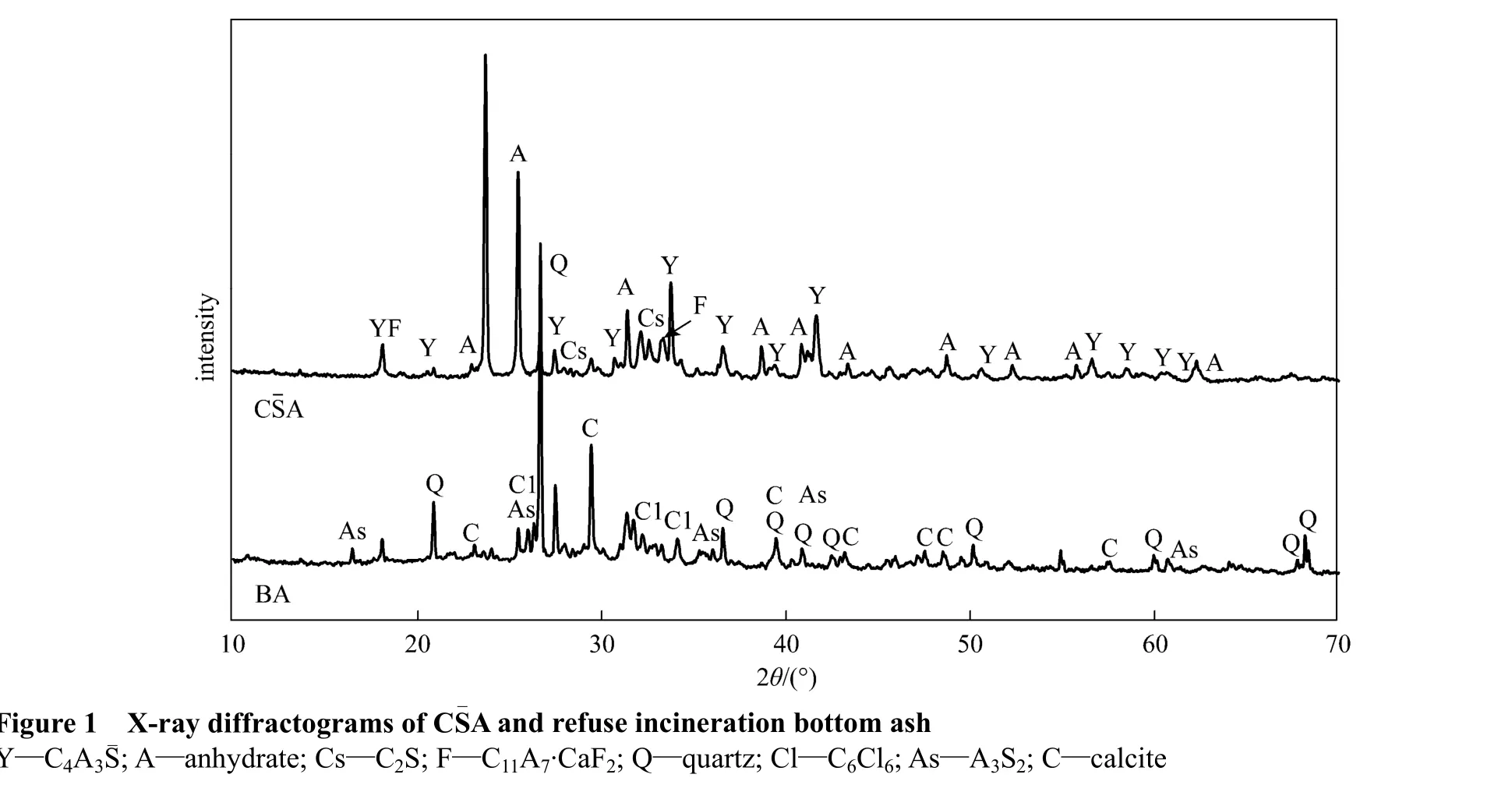
Furthermore, the morphological and chemical analyses were performed applying scanning electron microscopy (SEM) (JEOL JSM 6400, USA) with an energy dispersive X-ray (EDX) analysis system(INCA Energy 350, Oxford Instruments, UK).
Leaching tests were performed using the toxicity characteristic leaching procedure (US EPA Test Method 1311-TCLP), except that the duration of the overall test was longer. The test consisted on a set of parallel batch extractions of crashed materials (<9.5 mm)at a liquid-to-solid ratio of 20∶1, where sub-samples of material (25 g) were in contact with acetic acid solution (5.7 ml acetic acid in 1 L of distilled water).The samples were then rotated end over end for a maximum period of 840 h at 32 r·min-1with a cubic vibrator. Part of leachate was collected cumulatively for first 24 h and all 840 h separately, filtered through 0.45 μm cellulose membrane filter and then analyzed using Optima 2100 DV ICP-AES (PerkinElmer, USA)for the leachable heavy metals of concern (As, Ba, Cd,Cr, Cu, Pb, Mn, Zn and Ni) and using TOC-VCPN analyzer (Shimadzu, USA) for total organic carbon (TOC).All leaching tests were done in triplicate. The results reported here were the average values of measurements.
3 RESULTS AND DISCUSSION_
3.1 Characterization of CS A and refuse incineration bottom ash
The XRD patterns of CSA clinker and refuse incineration b_ottom ash are illustrated in Fig. 1. As can be seen, CSA c_linker was composed principally of yeelimite (C4A3S), belite (C2S) and anhydrate (CaSO4),corresponding to the rays at 23.7°, 32.1° and 25.5°(2θ). The characteristic weak peaks at 17.5° and 33.7°(2θ) confirmed the presence of calcium fluoroaluminate (C11A7·CaF2). As to bottom ash, moderate crystalline, like quartz (SiO2) at 26.7° (2θ), calcite (CaCO3)at 29.5° (2θ), mullite (3Al2O3·2SiO2) at 16.5° and 26.3° (2θ), as well as carbon chloride (C6Cl6) at 26.3°(2θ) could be identified respectively.
3.2 Compressive strength
Unconfined compressive strength of CLSM mixes after 28 d of curing is presente_d in Fig. 2. As expected, the greater the amount of CS A cement substituted by wastes, the lower was the compressive strength of CLSM obtained. The highest strength of about 9.0 MPa were obt_ained for Mortar-Ref with(sludge: bottom ash)∶CS A_1∶0∶4. Mortar-I with(sludge∶bottom ash)∶CS A ratio of 1∶0.4∶3.6,however, provided a 28-day strength of approximately 7.8 MPa, with a 13% strength loss as comp_ared to Mortar-Ref. When (sludge∶bottom ash)∶CSA ratio was further increased to (1∶3.2)∶0.8, a strength of around 3.6 MPa was obtained for the Mortar-V sample.The drastic decline in strength might partially be ascribed to the weakened van der Waals forces between hydrated particles [13] due to the deleterious effects of insoluble metal gels and organic materials [14] from raw materials.
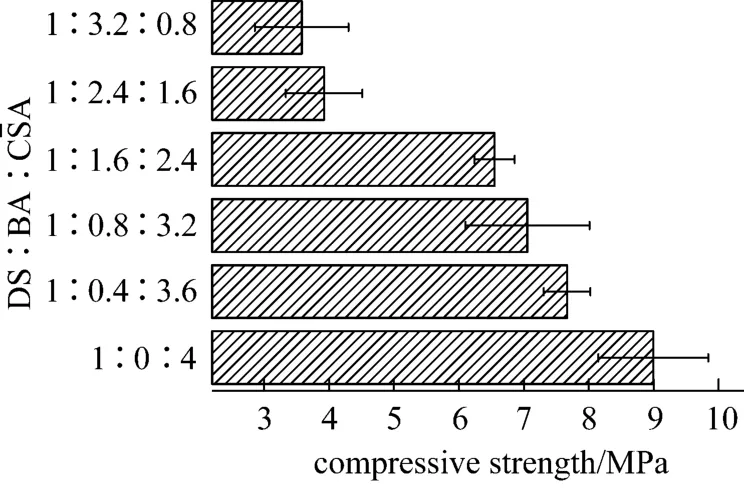
Figure 2 The effect of (sludge: bottom ash): CS A ratios on 28-day strength of CLSM specimens
Lachemiet al. [5] classified the CLSM with 28-day strength of 0.5-2.1 MPa as the excavatable fills,which were considered suitable for use in non-structural engineering such as backfilling, pipe trench refilling,etc[13]. It was evident that the strength values of all CLSM specimens remarkably exceeded the upper excavatable limit. Therefore, CLSM mix designs manufactured herein seemed more acceptable in structural and non-excavation utilizations.
3.3 XRD analysis
XRD patterns of CLSM specimens after 28 d of hydration were shown in Fig. 3. The results revealed that sludge and bottom ash gently modified the relative amount of minerals in the mortar_s depending on the ratio of (sludge∶bottom ash)∶CS A. In the cases of lower ratios, the samples displayed a similar result to Mortar-Ref. Beyond the ratio of (1∶1.6)∶2.3,however, a gradual decrease_could be clearly seen in crystalline ettringite (C3A·3CS·H32, or AFt) and calcite(CaCO3), in addition to a considerable increase in quartz (SiO2). This was mainly attributable to the presence of hydrocarbons in raw materials, which hindered the normal reactions occurring in CSA clinker to a degree. Nevertheless, the positions of characteristic peaks of hydrates in all CLSM samples appeared exactly similar (Fig. 3), indicating that the retardation was not seriously significant, which offered a beneficial explanation for the good strength development of the designed materials (Fig. 2).
Furthermore, in order to deeply disclose the cementitious mechanisms by which the_strength was enh_anced, the variations of phases C4A3S and CaSO4(CS) present in CLSM systems during the period of hydra_tion were_detected. The strong consumption of C4A3Sand CSat the later age (3 to 28 d) (Fig. 4)confirmed that the typical Pozzolanic Reaction,

took place [15], which subse_quently resulted in the formation of ettringite (C6AS3H32) and aluminium hydroxide (AH3) gels to provide good binding properties.In Reaction_(1), shorthand notations of C=CaO;A=Al2O3; S=SO3; H=H2O were used. Meanwhile,the reaction of metallic aluminum present_in bottom ash with the alkalis from the hydration of CS A cement might promote the precipitation of AH3gels as well [16].The presence of AH3was not detectable as stated before(Fig. 3) possibly because of its poo_rly crystalline [17].
Additionally, sufficient C4A3S was considered to be the source of Pozzolanic Reaction (2),
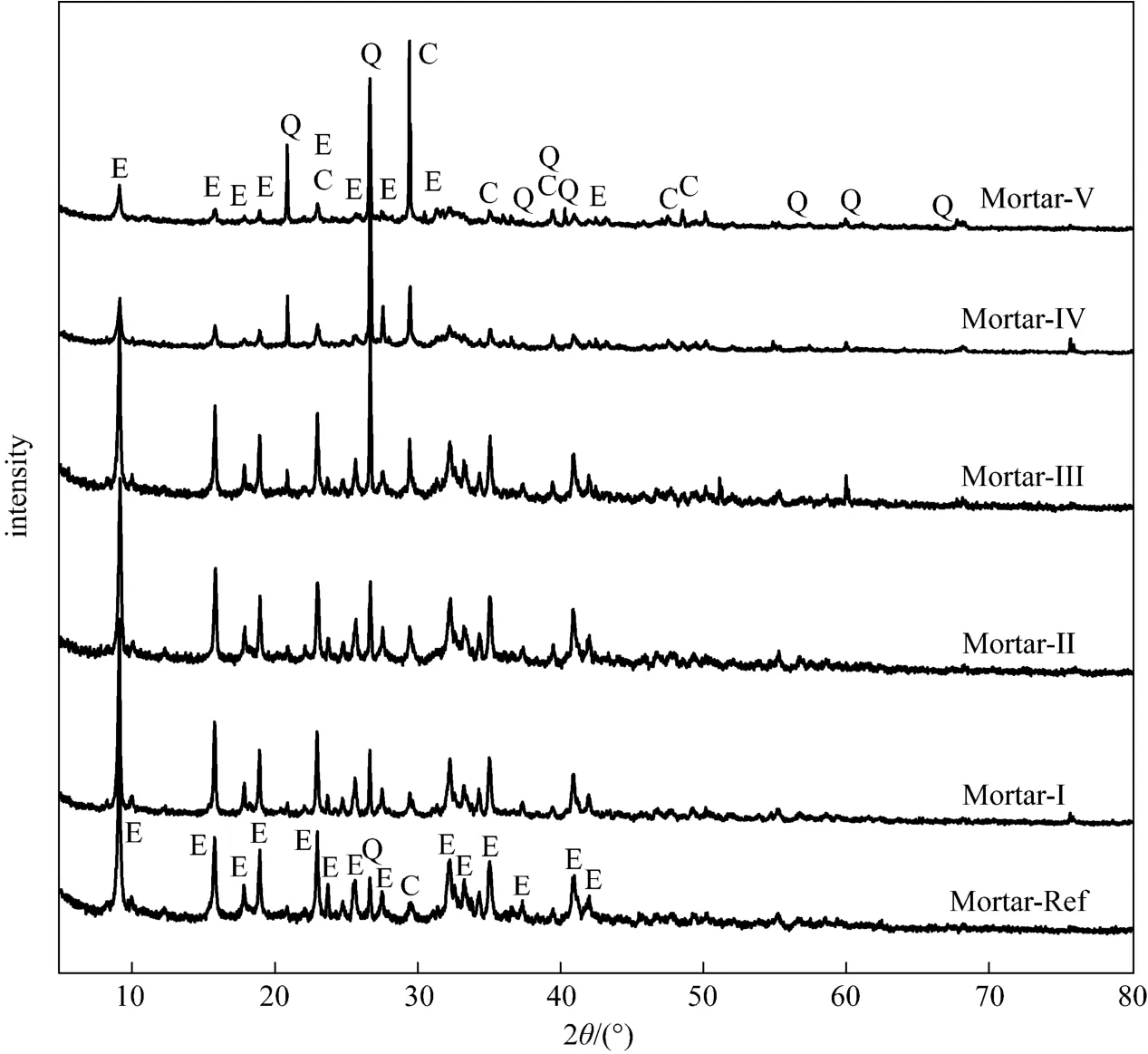
Figure 3 X-ray diffractograms of CLSM specimens at 28 d E—ettringite; Q—quartz; C—calcite
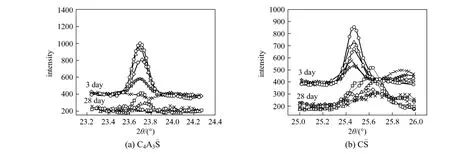
Figure 4 Variation of X-ray diffractograms of CLSM specimens with time illustrating and C□ Mortar-Ref; ○ Mortar-I; △ Mortar-II; ◇ Mortar-III; ☆ Mortar-IV; × Mortar-V
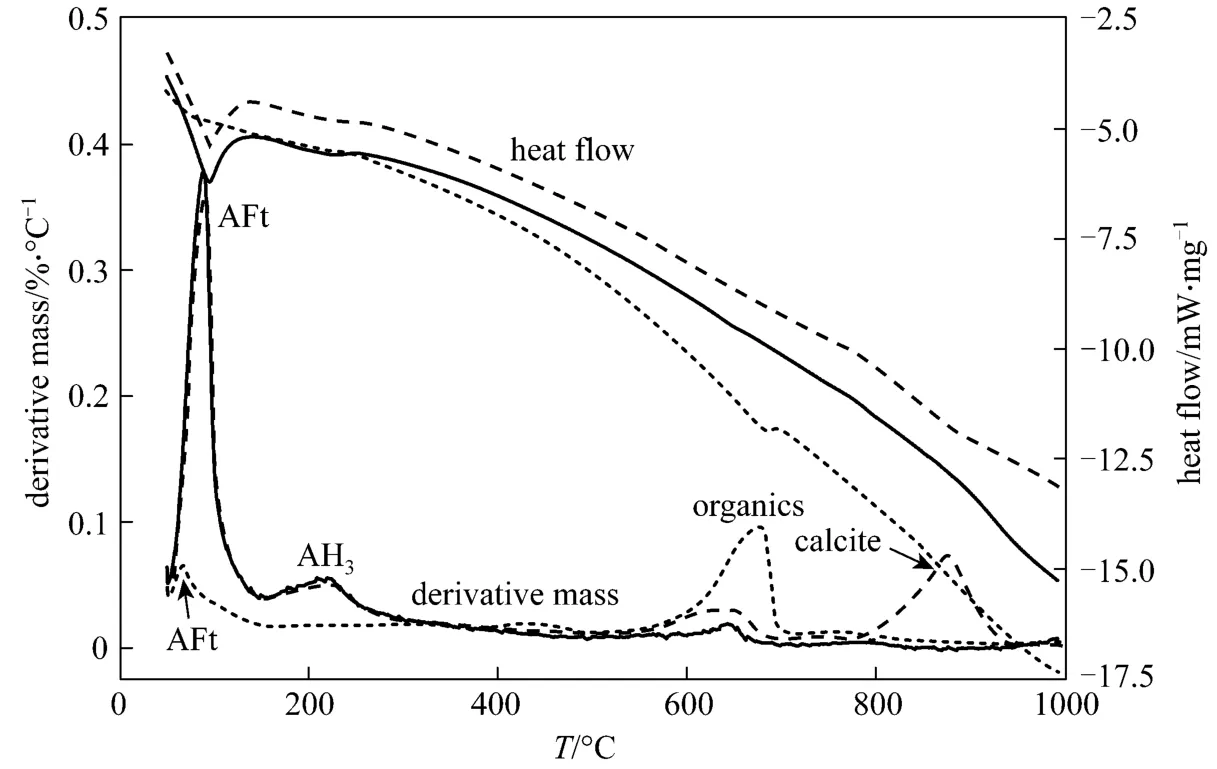
Figure 5 DTG-DSC curves of CLSM mortars Mortar-Ref; Mortar-I; Mortar-V
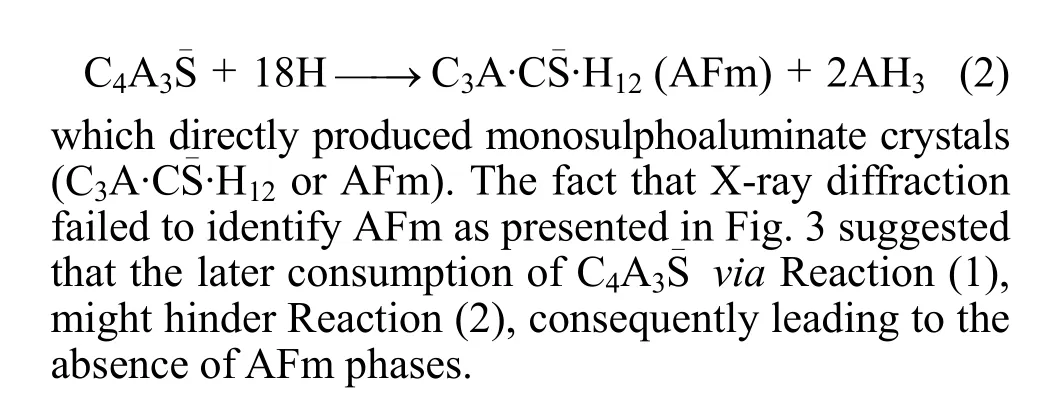
3.4 TG-DSC analysis
XRD has failed to indentify some poorly crystalline and amorphous phases, as described in Section 3.3. TG-DSC analysis was subsequently employed to detect certain chemical species present. Fig. 5 displays the DTG-DSC curves of all CLSM specimens after 28-day hydration. The broad mass loss peaks in the range 80-130 °C in DTG curves were most probably attributed to the decomposition of AFt-related gel. The corresponding endothermic peaks could also be found in DSC curves. The considerable signal in the 170-280 °C region was observed possibly because of the presence of AH3.
When further increasing temperature, a significant mass loss at around 650-700 °C appeared mainly thanks to the volatilization and destruction of organic compounds in sludge and bottom ash. Also, up to 880 °C or so the peaks with various intensities were visible,relating to CO2-loss of calcite. Apart from decarbonation of calcite, possible pyrolysis of certain inorganic minerals might also take place.
The intensity of peaks related to hydration process experienced variations depending on (sludge∶bottom ash)∶CS A ratios, though all CLSM mixtures had a similar thermal behavior as illustrated in Fig. 5.It can be found that the mass loss peaks for hydration products,i.e. AFt, AH3and CaCO3became evidently weak as the ratio increased, indicating that the inert matters from raw materials might depress the normal Pozzolanic Reactions and the precipitation of the crystalline phases.
3.5 FTIR analysis
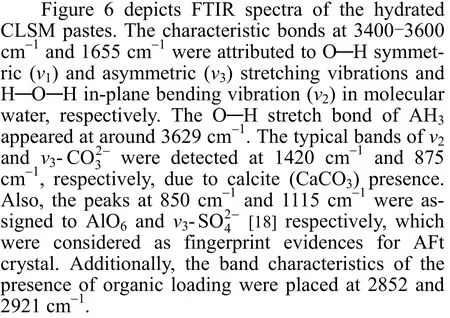
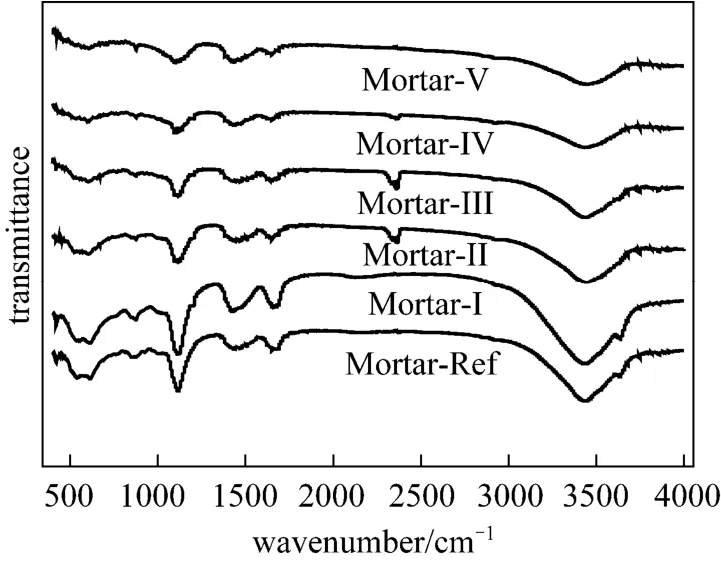
Figure 6 FTIR spectra of CLSM mortars cured for 28 d
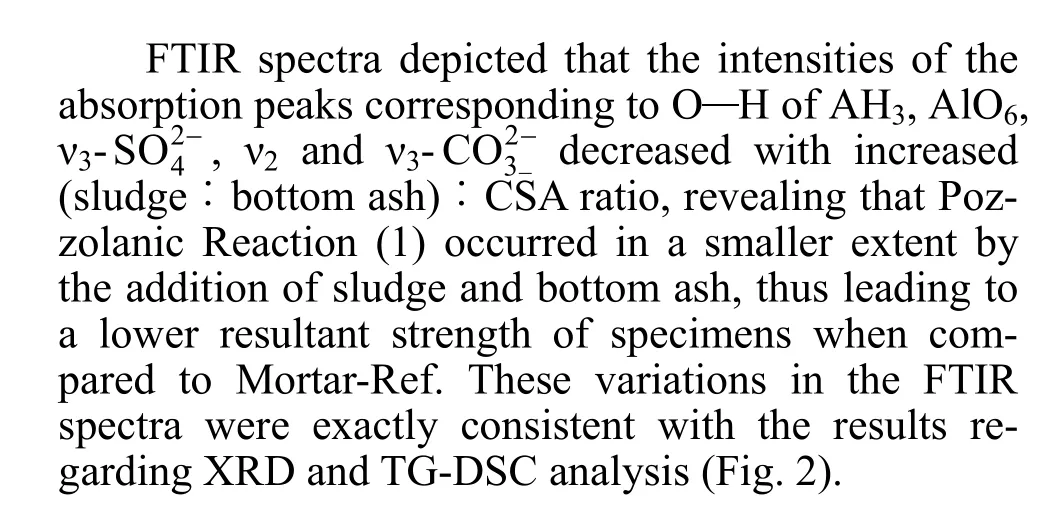
3.6 SEM-EDX analysis
The Mortar-Ref, II and V were subjected to SEM-EDX analysis to reliably investigate the effect of wastes presence on microstructures of CLSM matrixes.Visual observation of hydrated specimens obtained after 28 d in Fig. 7 reveals that the mortars exhibited similar microstructure and mineralogical compositions.The AFt crystal of needle-like morphology with lengths 10-20 μm was observed to extensively form in the available space offered by preexisting cracks and ash-paste interface. Simultaneously, the presence of AH3gels was very well confirmed with the help of EDX analysis with respect to a higher mass proportion of metallic aluminum in these areas (about 7.9%,9.1% and 8.9% for Mortar-Ref, II and V, respectively).In addition to the identifiable hydration products discussed above, other abnormal compounds like kalium,magnesium and titanium bearing phases were also recognized at the interface between cement paste and waste grains.
When comparing the SEM images of three CLSM mortars, the needle-shaped AFt crystals present in Mortar-Ref appeared clearly visible and regular,displaying a relatively high crystallinity. The crystals in Mortar-II, especially in Mortar-V, however, seemed more irregular with some exiguous tubers around them. The slight distinction in microstructure could be due to the fact that the available sludge and bottom ash have participated into the hydration of CS A clinkerviaReaction (1), and became crystallochemically incorporated within the needle-like AFt phase, thus leading to the irregular morphology [Figs. 7 (a) and 7(b)]. While some coarse sludge and bottom ash particles remained nearly un-hydrated except of their surfaces as shown in Fig. 7 (a), they acted as aggregates of the sludge-bottom ash-amended materials and yielded the strength framework of the matrix [19]. The hydration products,i.e. AFt, AH3and CaCO3interluded among the different particles and enhanced the contacts of the aggregates which consequently contributed a lot to material strength development (Fig. 2).
From these findings, it could be rightly stated that sludge and bottom ash were truly applied as additional ingredients in CLSM production. From the fact that the smaller the particle size, the higher the cementitious activity of materials, it could be verified that bottom ash would be more beneficial in promoting the early strength of CLSM, provided that an excellent fineness comparable to that typical of cement was reached [11].
3.7 Leaching behaviour of CLSM mortars
To determine the effectiveness of immobilization and the mechanism of leaching of contaminants from CLSM forms, TCLP tests were performed. The experimental results for the targeted heavy metals and corresponding regulatory thresholds were presented respectively in Table 2.
It was found that the cumulative amounts of metals leached from CLSM were considerably low, much below the regulatory thresholds. A slight increase in Cu from 0.08-0.13 mg·L-1to 2.22-2.42 mg·L-1was observed as the (sludge∶bottom ash)∶CS A ratio increased, as shown in Table 2. In the case of As (arsenic), each specimen exhibited very low cumulative leachability of 0.02 mg·L-1. The similar behaviors were also observed for Ba, Mn and Ni, regardless of(sludge∶bottom ash)∶CS A ratio and leaching time,demonstrating very high immobility. Contrary to what were observed for the metals discussed, the effect of the increasing waste loading in CLSM mortars was more pronounced in preventing Cr and Pb leaching.As can be seen from Table 2, the cumulative leaching
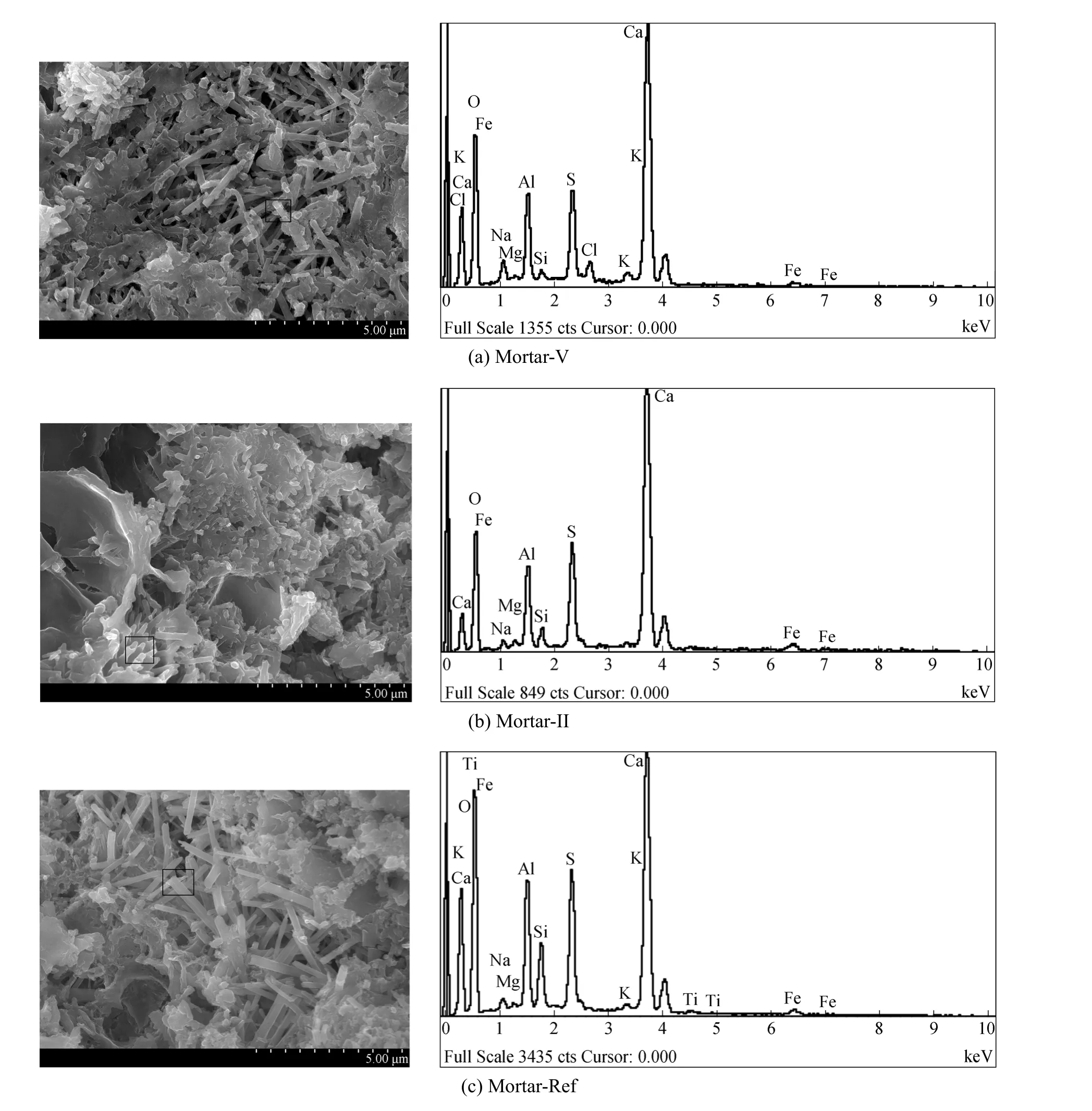
Figure 7 SEM-EDX spectrums of Mortar-V, Mortar-II and Mortar-Ref cured for 28 d
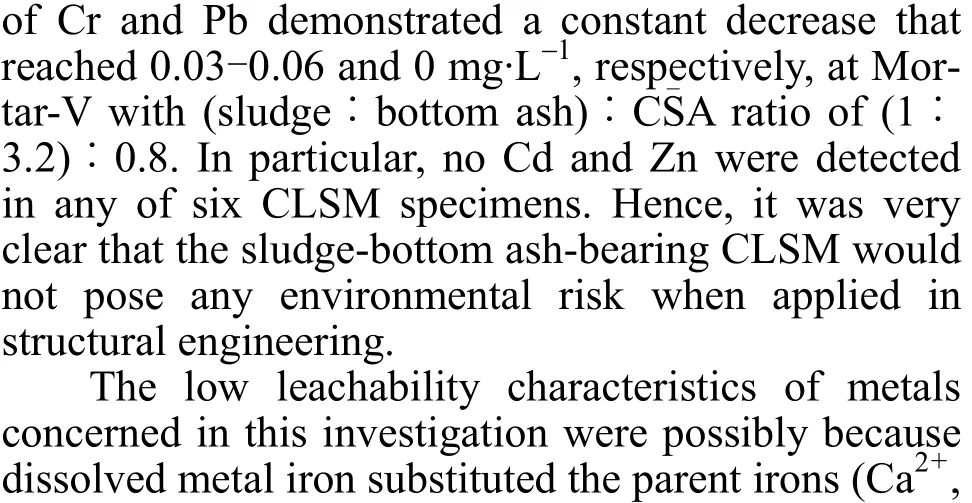

Furthermore, TOC concentrations in the extracts were measured. It was found that all CLSM dosages exhibited low TOC leaching ranging from 365 to 635 mg·L-1. These concentrations nearly could not pose health harm since leachate would eventually get diluted and attenuated if discharged into the nature. The porosity decrease and sinuousness of the porous systemdue to the formation of hydration crystals were presumably responsible for the low leachability.

Table 2 Cumulative fractions of leachable substances in TCLP test (mg·L-1)
4 CONCLUSIONS
Increasing both sewage sludge and bottom ash contents in CLSM have not seriously influenced on the strength development. The strength of CLSM mixtures tested was in the range of 3.6-9.0 MPa at 28 d.The micro-structural analysis revealed that sewage sludge and bottom ash were crystallochemically incorporated within CLSM systems by forming the needle-like AFt phase with exiguous tubersviathe typical Pozzolanic Reaction, leading to a dense and low-porosity microstructure. Furthermore, TCLP tests evidenced that all leachable substances measured on the leachates were relatively low, exhibiting negligible health and environmental risks. The good mechanical strength and related low leachability observed after 28 d of curing, therefore, were strongly encouraging and promising for the recycling and reuse of sewage sludge and refuse incineration bottom ash for CLSM production in the direction of sustainability.
1 Gabr, M.A., Bowders, J.J., “Controlled low-strength material using fly ash and AMD sludge”,J.Hazard.Mater., 76, 251-263 (2000).
2 ACI, 229R, Controlled Low Strength Materials, American Concrete Institute, Farmington Hills, MI, USA (1999).
3 Katz, A., Kovler, K., “Utilization of industrial by-products for the production of controlled low strength materials (CLSM)”,Waste Manage., 24, 501-512 (2004).
4 Razak, H.A., Naganathan, S., Hamid, S.N.A., “Performance appraisal of industrial waste incineration bottom ash as controlled low-strength material”,J.Hazard.Mater., 172, 862-867 (2009).
5 Lachemi, M., Sahmaran, M., Hossain, K.M.A., Lotfy, A., Shehata,M., “Properties of controlled low-strength materials incorporating cement kiln dust and slag”,Cement Concrete Comp., 32, 623-629(2010).
6 Shon, C.S., Mukhopadhyay, A.K., Saylak, D., Zollinger, D.G., Mejeoumov, G.G., “Potential use of stockpiled circulating fluidized bed combustion ashes in controlled low strength material (CLSM) mixture”,Constr.Build.Mater., 24, 839-847 (2010).
7 Van Gerven, T., Van Keer, E., Arickx, S., Jaspers, M., Wauters, G.,Vandecasteele, C., “Carbonation of MSWI-bottom ash to decrease heavy metal leaching in view of recycling”,Waste Manage., 25,291-300 (2005).
8 Lin, K.L., Chang, W.C., Lsin, D.F., “Pozzolanic characteristics of pulverized incinerator bottom ash slag”,Constr.Build.Mater., 22,324-329 (2008).
9 Wang, K.S., Chiou, I.J., Chen, C.H., Wan, D., “Light weight properties and pore structure of foamed material made from sewage sludge ash”,Constr.Build.Mater., 19, 627-633 (2005).
10 Chen, H.X., Ma, X.W., Dai, H.J., “Reuse of water purification sludge as raw material in cement production”,Cement Concrete Com., 32,436-439 (2010).
11 Bertolini, L., Carsana, M., Cassago, D., Curzio, A.Q., Collepardi, M.,“MSWI ashes as mineral additions in concrete”, Cement Concrete Res., 34, 1899-1906 (2004).
12 Lee, T.C., Li, Z.S., “Conditioned MSWI ash-slag-mix as a replacement for cement in cement mortar”, Constr. Build. Mater., 24, 970-979(2010).
13 Naganathan, S., Razak, H.A., Hamid, S.N.A., “Effect of kaolin addition on the performance of controlled low-strength material using industrial waste incineration bottom ash”, Waste Manage. Res., 28,848-860 (2010).
14 Gastaldi, D., Canonico, F., Boccaleri, E., “Ettringite and calcium sulfoaluminate cement: investigation of water content by near-infrared spectroscopy”, J. Mater. Sci., 44, 5788-5794 (2009).
15 Coumes, C.C.D., Courtois, S., Peysson, S., Ambroise, J., Pera, J.,“Calcium sulfoaluminate cement blended with OPC: A potential binder to encapsulate low-level radioactive slurries of complex chemistry”, Cement Concrete Res., 39, 740-747 (2009).
16 Saikia, N., Cornelis, G., Mertens, G., Elsen, J., Van Balen, K., Van Gerven, T., Vandecasteele, C., “Assessment of Pb-slag, MSWI bottom ash and boiler and fly ash for using as a fine aggregate in cement mortar”, J. Hazard. Mater., 154, 766-777 (2008).
17 Winnefeld, F., Lothenbach, B., “Hydration of calcium sulfoaluminate cements—Experimental findings and thermodynamic modeling”, Cement Concrete Res., 40, 1239-1247 (2010).
18 Perkins, R.B., Palmer, C.D., “Solubility of ettringite(Ca6[Al(OH)s]2(SO4)3·26H2O) at 5-75 °C”, Geochim. Cosmochim.Acta, 63, 1969-1980 (1999).
19 Shen, W.G., Zhou, M.K., Ma, W., Hu, J.Q., Cai, Z., “Investigation on the application of steel slag-fly ash-phosphogypsum solidified material as road base material”, J. Hazard. Mater., 164, 99-104 (2009).
20 Cheng, T.W., Chu, J.P., Tzeng, C.C., Chen, Y.S., “Treatment and recycling of incinerated ash using thermal plasma technology”, Waste Manage., 22, 485-490 (2002).
猜你喜欢
杂志排行
Chinese Journal of Chemical Engineering的其它文章
- Festschrift in Honor of the 90thBirthday of Prof. Chen Jiayong
- Ternary System of Fe-based Ionic Liquid, Ethanol and Water for Wet Flue Gas Desulfurization*
- The Research Progress of CO2Capture with Ionic Liquids*
- Synthesis of PGMA Microspheres with Amino Groups for High-capacity Adsorption of Cr(VI) by Cerium Initiated Graft Polymerization*
- Solvothermal Synthesis and Optical Performance of One-dimensional Strontium Hydroxyapatite Nanorod*
- Effects of Additives and Coagulant Temperature on Fabrication of High Performance PVDF/Pluronic F127 Blend Hollow Fiber Membranes via Nonsolvent Induced Phase Separation
